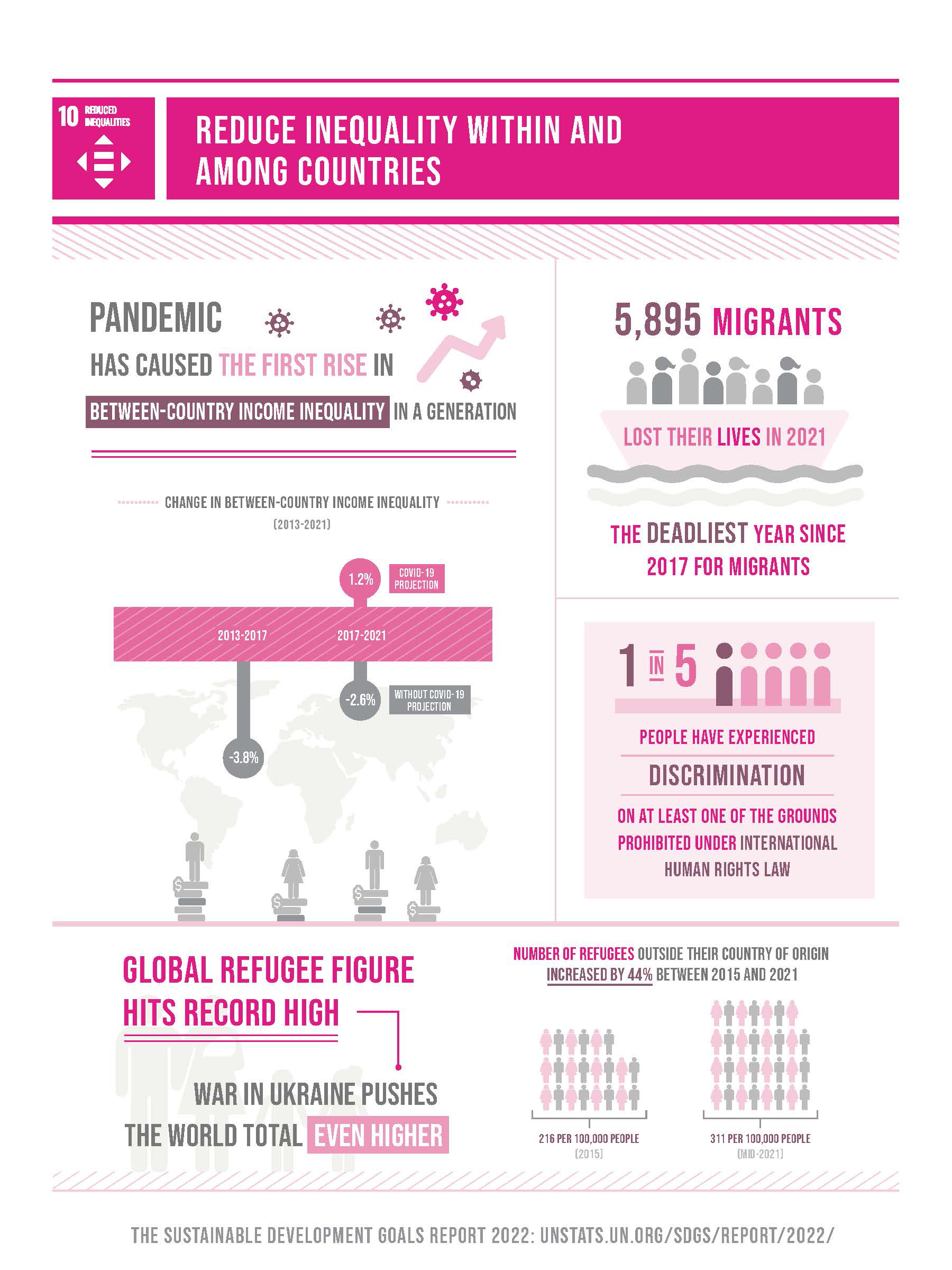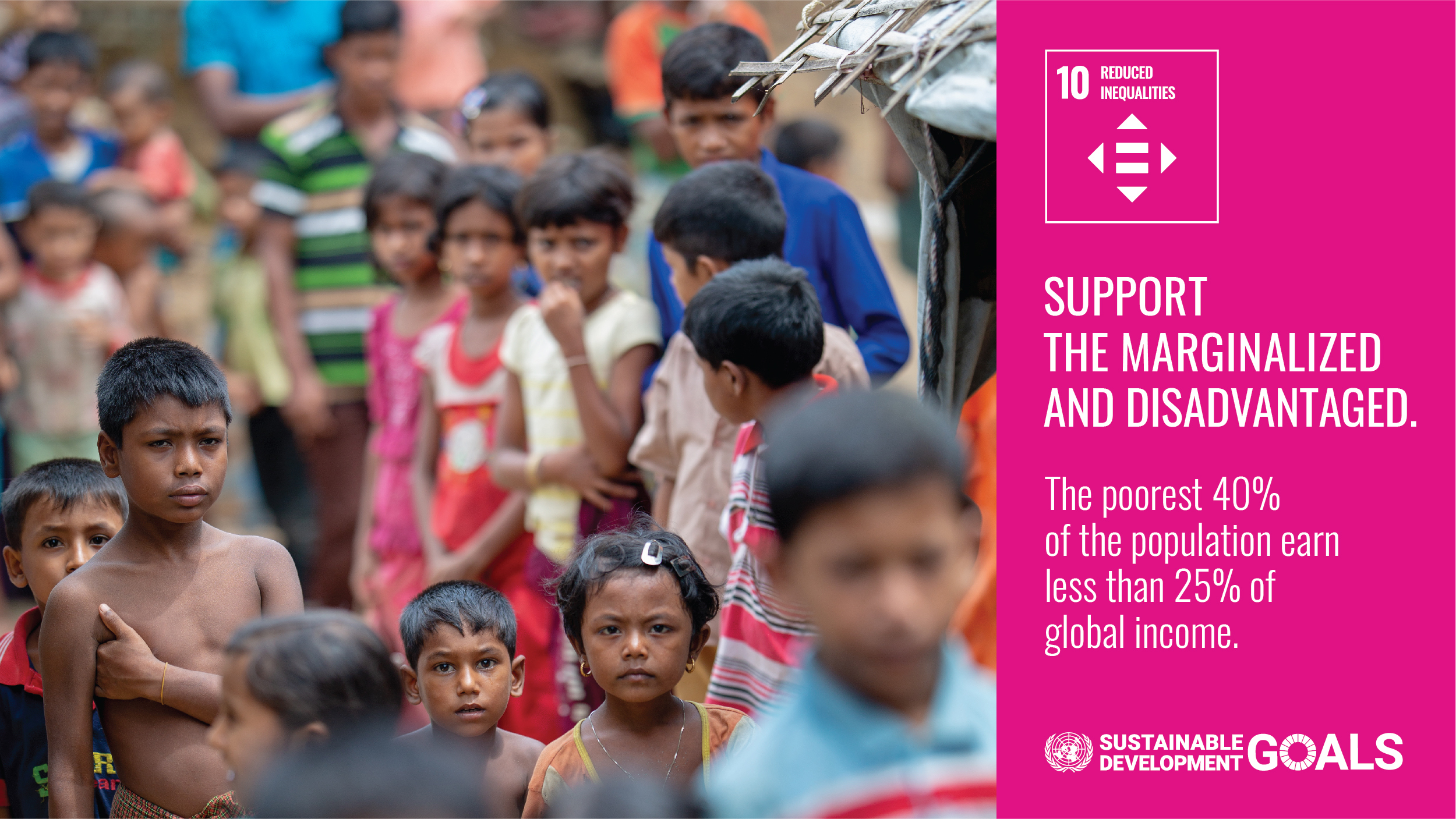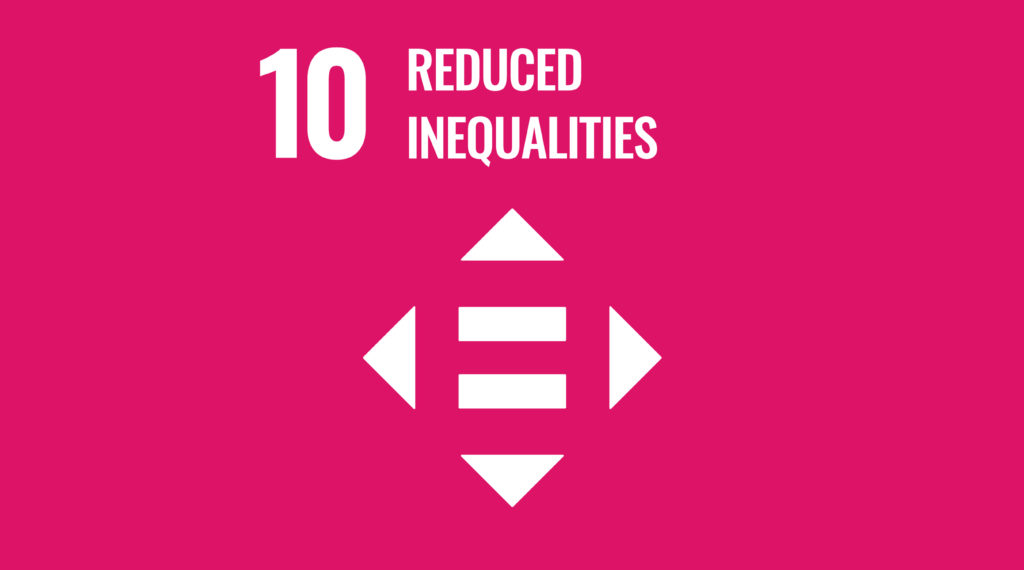Reduced Inequalities
Reduced inequalities and ensuring no one is left behind are integral to achieving the Sustainable Development Goals. Inequality within and among countries is a persistent cause for concern.
The effects of the COVID-19 pandemic appear to be reversing any positive trends of narrowing income inequality. The pandemic has also intensified structural and systemic discrimination. Emerging markets and developing economies are experiencing slow recoveries, widening disparities in income between countries. The number of refugees and migrant deaths worldwide reached the highest absolute number on record in 2021.
Meanwhile, the war in Ukraine rages on, forcing even more people from their homes and creating one of the largest refugee crises in recent memory.
Sustainable Development Goals
The 2030 Agenda for Sustainable Development was adopted by all United Nations Member states in 2015, an agenda that provides a shared blueprint for peace and prosperity for people and the planet, now and into the future.
The 17 Sustainable Development Goals (SDGs) are an urgent call for action by all countries – developed and developing – in a global partnership. They recognize that ending poverty and other deprivations must go hand-in-hand with strategies that improve health and quality education, reduce inequality, and spur economic growth – all while tackling climate change and working to preserve our oceans and forests. Learn more about the UN SDG’s.

What’s the goal here?
To reduce inequalities within and among countries.
Why?
Inequalities based on income, sex, age, disability, sexual orientation, race, class, ethnicity, religion and opportunity continue to persist across the world. Inequality threatens long-term social and economic development, harms poverty reduction and destroys people’s sense of fulfilment and self-worth. This, in turn, can breed crime, disease and environmental degradation.
We cannot achieve sustainable development and make the planet better for all if people are excluded from the chance for a better life. And despite some positive signs, inequality is growing for more than 70 per cent of the global population, exacerbating the risks of divisions and hampering economic and social development. Furthermore, COVID-19 is hitting the most vulnerable people the hardest, and those same groups are often experiencing increased discrimination.
What are some examples of inequality?
Women and children with lack of access to healthcare die each day from preventable diseases such as measles and tuberculosis or in childbirth. Older persons, migrants and refugees face lack of opportunities and discrimination – an issue that affects every country in the world. One in five persons reported being discriminated on at least one ground of discrimination prohibited by international human rights law.
Among those with disabilities, 3 in 10 personally experienced discrimination, with higher levels still among women with disabilities, including based on religion, ethnicity and sex, pointing to the urgent need for measures to tackle multiple and intersecting forms of discrimination.
How do we tackle discrimination?
In today’s world, we are all interconnected. Problems and challenges like poverty, climate change, migration or economic crises are never just confined to one country or region. Even the richest countries still have communities living in abject poverty. The oldest democracies still wrestle with racism, homophobia and transphobia, and religious intolerance. Global inequality affects us all, no matter who we are or where we are from.
Can we achieve equality for everyone?
It can – and should be – achieved to ensure a life of dignity for all. Political, economic and social policies need to be universal and pay particular attention to the needs of disadvantaged and marginalized communities.
What can we do?
Reducing inequality requires transformative change. Greater efforts are needed to eradicate extreme poverty and hunger, and invest more in health, education, social protection and decent jobs especially for young people, migrants and refugees and other vulnerable communities.
Within countries, it is important to empower and promote inclusive social and economic growth. We can ensure equal opportunity and reduce inequalities of income if we eliminate discriminatory laws, policies and practices.
Among countries, we need to ensure that developing countries are better represented in decision-making on global issues so that solutions can be more effective, credible and accountable.
Governments and other stakeholders can also promote safe, regular and responsible migration, including through planned and well-managed policies, for the millions of people who have left their homes seeking better lives due to war, discrimination, poverty, lack of opportunity and other drivers of migration.
United Nation Sustainable Development Goals
(United Nations why it matters)

Facts and Figures
- The effects of the pandemic have intensified social exclusion. Among the 18 countries which have data for 2020, two thirds saw rates of relative low income increase in 2020.
- Projections suggest that between-country inequality rose by 1.2 per cent between 2017 and 2021, the first such increase in a generation. Before the pandemic, inequality was expected to have fallen by 2.6 per cent over the same period.
- Income inequality within countries will also have increased around 1 per cent, on average, in emerging market and developing countries, halting the steady decline seen in these countries since the start of the millennium.
- Roughly one in five people have experienced discrimination on at least one of the grounds prohibited under international human rights law, such as ethnicity, age, sex, disability, religion and sexual orientation.
- In some countries, women are more than twice as likely as men to experience discrimination on the grounds of sex. One third of persons with disabilities experience discrimination.
- A decline in the labour share of income from 2014 to 2019 ‐ from 54.1 per cent to 52.6 per cent ‐ represents upward pressure on inequality.
- By mid-2021, the number of people forced to flee their countries had grown to a record high 24.5 million. For every 100,000 people worldwide, 311 are refugees outside their country of origin, up 44 per cent from 216 per 100,000 people in 2015.
- Countries in Northern Africa and Western Asia were the largest regional source of refugees (8.4 million), followed by countries in sub-Saharan Africa (6.7 million), and Latin America and the Caribbean (4.5 million).
- As of 23 May 2022, more than 6 million people in Ukraine had moved to other countries to escape the conflict, with at least 8 million people displaced inside the country.
- In 2021, 5,895 people died fleeing their countries, surpassing pre-pandemic figures and making 2021 the deadliest year on record for migrants since 2017.
Source: The Sustainable Development Goals Report 2022
Goal 10 Targets
- 10.1 By 2030, progressively achieve and sustain income growth of the bottom 40 per cent of the population at a rate higher than the national average
- 10.2 By 2030, empower and promote the social, economic and political inclusion of all, irrespective of age, sex, disability, race, ethnicity, origin, religion or economic or other status
- 10.3 Ensure equal opportunity and reduce inequalities of outcome, including by eliminating discriminatory laws, policies and practices and promoting appropriate legislation, policies and action in this regard
- 10.4 Adopt policies, especially fiscal, wage and social protection policies, and progressively achieve greater equality
- 10.5 Improve the regulation and monitoring of global financial markets and institutions and strengthen the implementation of such regulations
- 10.6 Ensure enhanced representation and voice for developing countries in decision-making in global international economic and financial institutions in order to deliver more effective, credible, accountable and legitimate institutions
- 10.7 Facilitate orderly, safe, regular and responsible migration and mobility of people, including through the implementation of planned and well-managed migration policies
- 10.A Implement the principle of special and differential treatment for developing countries, in particular least developed countries, in accordance with World Trade Organization agreements
- 10.B Encourage official development assistance and financial flows, including foreign direct investment, to States where the need is greatest, in particular least developed countries, African countries, small island developing States and landlocked developing countries, in accordance with their national plans and programmes
- 10.C By 2030, reduce to less than 3 per cent the transaction costs of migrant remittances and eliminate remittance corridors with costs higher than 5 per cent
Links:
United Nations Department of Economic and Social Affairs

We, at AI for Good foundation, are using AI + ML initiatives in pursuit of the 17 SDGs. With various projects in progress, such as our Climate Trend Scanner and the SDG Data Catalog, we are determined to help and facilitate achieving the goals.







